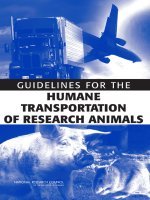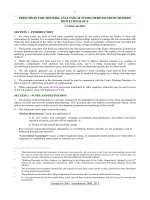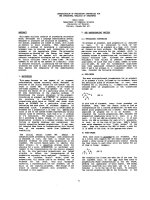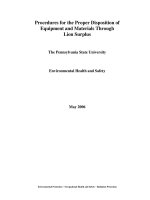PRINCIPLES FOR THE RISK ANALYSIS OF FOODS DERIVED FROM MODERN BIOTECHNOLOGY
Bạn đang xem bản rút gọn của tài liệu. Xem và tải ngay bản đầy đủ của tài liệu tại đây (44.21 KB, 3 trang )
-1-
Adopted in 2003. Amendments 2008, 2011
PRINCIPLES FOR THE RISK ANALYSIS OF FOODS DERIVED FROM MODERN
BIOTECHNOLOGY
CAC/GL 44-2003
SECTION 1 - INTRODUCTION
1. For many foods, the level of food safety generally accepted by the society reflects the history of their safe
consumption by humans. It is recognised that in many cases the knowledge required to manage the risks associated with
foods has been acquired in the course of their long history of use. Foods are generally considered safe, provided that
care is taken during development, primary production, processing, storage, handling and preparation.
2. The hazards associated with foods are subjected to the risk analysis process of the Codex Alimentarius Commission
to assess potential risks and, if necessary, to develop approaches to manage these risks. The conduct of risk analysis is
guided by general decisions of the Codex Alimentarius Commission
1
as well as the Codex Working Principles for Risk
Analysis
2
.
3. While risk analysis has been used over a long period of time to address chemical hazards (e.g. residues of
pesticides, contaminants, food additives and processing aids), and it is being increasingly used to address
microbiological hazards and nutritional factors, the principles were not elaborated specifically for whole foods.
4. The risk analysis approach can, in general terms, be applied to foods including foods derived from modern
biotechnology. However, it is recognised that this approach must be modified when applied to a whole food rather than
to a discrete hazard that may be present in food.
5. The principles presented in this document should be read in conjunction with the Codex Working Principles for
Risk Analysis to which these principles are supplemental.
6. Where appropriate, the results of a risk assessment undertaken by other regulatory authorities may be used to assist
in the risk analysis and avoid duplication of work.
SECTION 2 – SCOPE AND DEFINITIONS
7. The purpose of these Principles is to provide a framework for undertaking risk analysis on the safety and nutritional
aspects of foods derived from modern biotechnology. This document does not address environmental, ethical, moral
and socio-economic aspects of the research, development, production and marketing of these foods
3
.
8. The definitions below apply to these Principles:
“Modern Biotechnology” means the application of:
i) In vitro nucleic acid techniques, including recombinant deoxyribonucleic acid (DNA) and direct
injection of nucleic acid into cells or organelles, or
ii) Fusion of cells beyond the taxonomic family,
that overcome natural physiological reproductive or recombinant barriers and that are not techniques used in
traditional breeding and selection
4
.
“Conventional Counterpart” means a related organism/variety, its components and/or products for which there is
experience of establishing safety based on common use as food
5
.
1
These decisions include the Statements of principle concerning the role of science in the Codex decision-making process and
the extent to which other factors are taken into account and the Statements of principle relating to the role of food safety risk
assessment (Codex Alimentarius Commission Procedural Manual; Thirteenth edition).
2
“Working Principles for Risk Analysis for Application in the Framework of the Codex Alimentarius”(adopted by the 26
th
Session of the Codex Alimentarius Commission, 2003; Codex Alimentarius Commission Procedural Manual; Thirteenth
edition)
3
This document does not address animal feed and animals fed such feed except insofar as these animals have been developed
by using modern biotechnology.
4
This definition is taken from the Cartagena Biosafety Protocol under the Convention on Biological Diversity.
5
It is recognized that for the foreseeable future, foods derived from modern biotechnology will not be used as conventional
counterparts.
-2-
SECTION 3 – PRINCIPLES
9. The risk analysis process for foods derived from modern biotechnology should be consistent with the Codex
Working Principles for Risk Analysis.
RISK ASSESSMENT
10. Risk assessment includes a safety assessment, which is designed to identify whether a hazard, nutritional or other
safety concern is present, and if present, to gather information on its nature and severity. The safety assessment should
include a comparison between the food derived from modern biotechnology and its conventional counterpart focusing
on determination of similarities and differences. If a new or altered hazard, nutritional or other safety concern is
identified by the safety assessment, the risk associated with it should be characterized to determine its relevance to
human health.
11. A safety assessment is characterized by an assessment of a whole food or a component thereof relative to the
appropriate conventional counterpart:
A) taking into account both intended and unintended effects;
B) identifying new or altered hazards;
C) identifying changes, relevant to human health, in key nutrients.
12. A pre-market safety assessment should be undertaken following a structured and integrated approach and be
performed on a case-by-case basis. The data and information, based on sound science, obtained using appropriate
methods and analysed using appropriate statistical techniques, should be of a quality and, as appropriate, of quantity
that would withstand scientific peer review.
13. Risk assessment should apply to all relevant aspects of foods derived from modern biotechnology. The risk
assessment approach for these foods is based on a consideration of science-based multidisciplinary data and information
taking into account the factors mentioned in the accompanying Guidelines
6
.
14. Scientific data for risk assessment are generally obtained from a variety of sources, such as the developer of the
product, scientific literature, general technical information, independent scientists, regulatory agencies, international
bodies and other interested parties. Data should be assessed using appropriate science-based risk assessment methods.
15. Risk assessment should take into account all available scientific data and information derived from different testing
procedures, provided that the procedures are scientifically sound and the parameters being measured are comparable.
RISK MANAGEMENT
16. Risk management measures for foods derived from modern biotechnology should be proportional to the risk, based
on the outcome of the risk assessment and, where relevant, taking into account other legitimate factors in accordance
with the general decisions of the Codex Alimentarius Commission
7
as well as the Codex Working Principles for Risk
Analysis.
17. It should be recognised that different risk management measures may be capable of achieving the same level of
protection with regard to the management of risks associated with safety and nutritional impacts on human health, and
therefore would be equivalent.
18. Risk managers should take into account the uncertainties identified in the risk assessment and implement
appropriate measures to manage these uncertainties.
19. Risk management measures may include, as appropriate, food labelling
8
conditions for marketing approvals and
post-market monitoring.
20. Post-market monitoring may be an appropriate risk management measure in specific circumstances. Its need and
utility should be considered, on a case-by-case basis, during risk assessment and its practicability should be considered
during risk management. Post-market monitoring may be undertaken for the purpose of:
A) verifying conclusions about the absence or the possible occurrence, impact and significance of potential
consumer health effects; and
6
Reference is made to the Guideline for the Conduct of Food Safety Assessment of Foods Derived from Recombinant-DNA
Plants (CAC/GL 45-2003), the Guideline for the Conduct of Food Safety Assessment of Foods Produced using Recombinant-
DNA Microorganisms (CAC/GL 46-2003) and the Guideline for the Conduct of Food Safety Assessment of Foods Derived
from Recombinant-DNA Animals (CAC/GL 68-2008).
7
See footnote 1.
8
Reference is made to the Compilation of Codex Texts Relevant to Labelling of Foods Derived from Modern Biotechnology
(CAC/GL 76-2011).
-3-
B) monitoring changes in nutrient intake levels, associated with the introduction of foods likely to significantly
alter nutritional status, to determine their human health impact.
21. Specific tools may be needed to facilitate the implementation and enforcement of risk management measures.
These may include appropriate analytical methods; reference materials; and, the tracing of products
9
for the purpose of
facilitating withdrawal from the market when a risk to human health has been identified or to support post-market
monitoring in circumstances as indicated in paragraph 20.
RISK COMMUNICATION
22. Effective risk communication is essential at all phases of risk assessment and risk management. It is an interactive
process involving all interested parties, including government, industry, academia, media and consumers.
23. Risk communication should include transparent safety assessment and risk management decision-making processes.
These processes should be fully documented at all stages and open to public scrutiny, whilst respecting legitimate
concerns to safeguard the confidentiality of commercial and industrial information. In particular, reports prepared on the
safety assessments and other aspects of the decision-making process should be made available to all interested parties.
24. Effective risk communication should include responsive consultation processes. Consultation processes should be
interactive. The views of all interested parties should be sought and relevant food safety and nutritional issues that are
raised during consultation should be addressed during the risk analysis process.
CONSISTENCY
25. A consistent approach should be adopted to characterise and manage safety and nutritional risks associated with
foods derived from modern biotechnology. Unjustified differences in the level of risks presented to consumers between
these foods and similar conventional foods should be avoided.
26. A transparent and well-defined regulatory framework should be provided in characterising and managing the risks
associated with foods derived from modern biotechnology. This should include consistency of data requirements,
assessment frameworks, the acceptable level of risk, communication and consultation mechanisms and timely decision
processes.
CAPACITY BUILDING AND INFORMATION EXCHANGE
27. Efforts should be made to improve the capability of regulatory authorities, particularly those of developing
countries, to assess, manage and communicate risks, including enforcement, associated with foods derived from modern
biotechnology or to interpret assessments undertaken by other authorities or recognised expert bodies, including access
to analytical technology. In addition capacity building for developing countries either through bilateral arrangements or
with assistance of international organizations should be directed toward effective application of these principles
10
.
28. Regulatory authorities, international organisations and expert bodies and industry should facilitate through
appropriate contact points including but not limited to Codex Contact Points and other appropriate means, the exchange
of information including the information on analytical methods.
REVIEW PROCESSES
29. Risk analysis methodology and its application should be consistent with new scientific knowledge and other
information relevant to risk analysis.
30. Recognizing the rapid pace of development in the field of biotechnology, the approach to safety assessments of
foods derived from modern biotechnology should be reviewed when necessary to ensure that emerging scientific
information is incorporated into the risk analysis. When new scientific information relevant to a risk assessment
becomes available the assessment should be reviewed to incorporate that information and, if necessary, risk
management measures adapted accordingly.
9
It is recognised that there are other applications of product tracing. These applications should be consistent with the
provisions of the SPS and TBT Agreements. The application of product tracing to the areas covered by both Agreements was
considered by the Codex Committee on Food Import and Export Inspection and Certification Systems, see CAC/GL 60-2006:
Principles for Traceability/Product Tracing as a Tool within a Food Inspection and Certification System.
10
Reference is made to technical assistance of provisions in Article 9 of the SPS Agreement and Article 11 of the TBT
Agreement.









